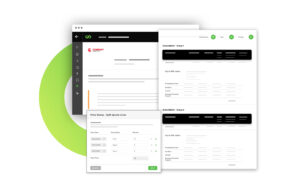CPQ Adoption Strategy: Why Training Alone Doesn’t Stick

Boost CPQ Adoption by Leading With the Quote Document
CPQ training often fails not because the content is weak—but because the system doesn’t feel intuitive to reps. Instead of forcing them to navigate workflows, show them the finished quote first. Visual CPQ workflows anchored in the final output help reps quote faster, avoid mistakes, and actually want to use the tool.
Why CPQ Training Doesn’t Result in Adoption
You’ve invested time and effort into CPQ enablement. You’ve explained the features, walked through deal flows, and even created cheat sheets.
But when reps get into the platform, they freeze:
- “Where do I even start?”
- “What happens if I get it wrong?”
- “How do I see what the quote will look like?”
The issue isn’t knowledge.
It’s lack of confidence and visual feedback.
And when reps don’t feel confident, they default to old habits—Excel, Slack pings, and Sales Ops requests.
The Hidden Barrier: Disconnected User Experience
CPQ was supposed to accelerate quoting. But reps still hesitate because:
- They can’t visualize the end product
- The UI is structured for operations, not sellers
- They feel like they’re building something blindly
- There’s no “safe space” to explore without fear of error
This disconnect creates a feedback loop:
Low confidence → Low usage → Low ROI.
The Fix: Anchor Reps With the Quote Document First
Instead of teaching reps to “build a quote,” show them what the final quote looks like from the start.
Modern CPQ systems support document-first workflows where:
- Reps preview a dynamic quote template at the beginning
- Product selection, discounting, and customization happens within the document view
- The quote updates in real time as changes are made
- Built-in rules enforce pricing and configuration logic
This flips the experience from intimidating to intuitive.
The Enablement Team’s Win
- Faster ramp time with fewer refresher trainings
- Fewer support tickets asking “How do I quote this?”
- Higher rep confidence, especially among new hires
- Increased CPQ adoption because reps actually like using it
- Better quote accuracy without additional policing
You’re not teaching software navigation—you’re enabling sales conversations.
Training-Based CPQ vs Quote-First CPQ Experience
Feature | Traditional CPQ Training Flow | Visual Quote-First Experience |
Onboarding Time | Long, requires repetition | Faster, rep-driven learning |
Confidence in Using CPQ | Low—fear of mistakes | High—visual clarity builds trust |
Quote Creation Process | Form-first, abstract | Document-first, contextual |
Engagement With Tool | Sporadic, limited to “have to” | Consistent, tied to workflow |
Impact on Sales Momentum | Delayed quotes, lost momentum | Faster proposals, fewer blockers |
Frequently Asked Questions (FAQs)
Why doesn’t CPQ training stick after rollout?
Because reps don’t feel confident navigating the system—especially if it’s structured for operations, not sales. They need visual clarity, not form fields.
How does previewing the quote document help?
It orients reps around the final outcome, reducing uncertainty. They can make changes in context and feel more in control of the quoting process.
Can this really increase CPQ adoption?
Yes. Reps are more likely to use tools that feel intuitive and helpful—especially when the learning curve is reduced by showing, not just telling.
Does this require a new CPQ tool?
Not necessarily. Many CPQ systems now support document-first workflows or preview modules. It’s about configuring the experience to match how reps think.
What does this change for enablement teams?
Less time spent on system training. More time focused on sales skills, discovery, and value messaging—because the system helps reps quote, not just click.
Related Posts

Price Ramping Maximizes Lifetime Value with Scalable Pricing
Price Ramping Maximizes Lifetime Value with Scalable Pricing Instead of locking customers into flat rates, Price Ramping lets you build subscription contracts that grow over time. By aligning pricing with customer value and usage maturity, you remove friction from deal closure while expanding revenue predictably. This feature is crucial for

Stop Training Reps on Product Rules—Let CPQ Do It For You
Stop Training Reps on Product Rules—Let CPQ Do It For You Reps Shouldn’t Memorize Product Rules—They Should Sell If you’re constantly teaching reps what they can’t quote, you’ve got a tooling issue—not a training one. With CPQ product rule automation, reps quote faster, avoid errors, and learn configurations as they

Renewal Based Upselling Turns Every Contract into a Growth Moment
Renewal Based Upselling Turns Every Contract into a Growth Moment Most SaaS companies treat renewals as a checkbox—but that’s a missed revenue opportunity. Renewal-based upselling embeds upgrade options directly into renewal workflows, driving higher ACV, better customer satisfaction, and faster upsell cycles. The key? Use contextual visibility, pre-built upgrade paths,
Ready to fix leaks, speed up quoting, and unlock hidden revenue?
Use our RoI Calculator to see where your business can grow next.


